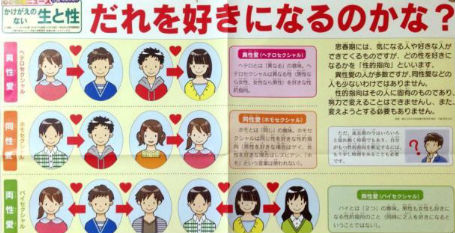Entitled 'Who will you come to like?' the poster is part of a series on healthcare issues called Kokoro Kenkou no Nyusu roughly translated from the Japanese to mean Mental Health News although kokoro or “heart” can also refer to emotional or spiritual well-being.
The poster using easy to understand explanations tells of differences between straight, gay, bisexual and asexual individuals, as well as explanations of how sexual orientation is discovered, and how it is innate and cannot be modified by outside pressures, according to ROYGBIV.
“Adolescence is a time when one generally discovers their sexual orientation… is innate and it cannot be changed by intervention, so there is no need to change your preferences,” the poster says. “When it comes to understanding one’s sexual orientation, one should take as much time as is needed,” it added.
This particular poster in the photo was posted outside the nurse’s office at Saitama Prefecture’s Sayama Keizai School of Economics.
A recent study about the rate of LGBT bullying in Japanese schools had pointed to the need for such informational posters to educate students on various sexual orientations and help students accept their peers.
Conducted by Inochi Risupekuto Howaito Ribon Kyanpen (the respect for life white ribbon campaign), the study included 609 participants. Of those respondents 68 percent experienced bullying at some level in elementary, junior high school, or high school.
The study showed that 53 percent were verbally abused and 49 percent were ignored or excluded from groups. About 20 percent experienced physical bullying and 11 percent suffered sexual abuse, such as having their clothes taken off by classmates, according to the study released in May and reported by Japan Times.
The results showed most of the bullies were classmates but 12 percent said they were also bullied by teachers.
Abuse periods were especially long for boys with gender identity disorder, with 43 percent saying they were bullied for more than five years. About half said they had no one to talk to about the bullying.
The survey found that 32 percent thought of committing suicide, with 22 percent saying they had injured themselves, such as by cutting their wrists.
Schools need to find ways to teach students about LGBTs to prevent those who don’t match stereotypical ‘masculine’ or ‘feminine’ gender types from being bullied, the report said.
Entitled 'Who will you come to like?' the poster is part of a series on healthcare issues called Kokoro Kenkou no Nyusu roughly translated from the Japanese to mean Mental Health News although kokoro or “heart” can also refer to emotional or spiritual well-being.The poster using easy to understand explanations tells of differences between straight, gay, bisexual and asexual individuals, as well as explanations of how sexual orientation is discovered, and how it is innate and cannot be modified by outside pressures, according to ROYGBIV.
“Adolescence is a time when one generally discovers their sexual orientation… is innate and it cannot be changed by intervention, so there is no need to change your preferences,” the poster says. “When it comes to understanding one’s sexual orientation, one should take as much time as is needed,” it added.
This particular poster in the photo was posted outside the nurse’s office at Saitama Prefecture’s Sayama Keizai School of Economics.
A recent study about the rate of LGBT bullying in Japanese schools had pointed to the need for such informational posters to educate students on various sexual orientations and help students accept their peers.
Conducted by Inochi Risupekuto Howaito Ribon Kyanpen (the respect for life white ribbon campaign), the study included 609 participants. Of those respondents 68 percent experienced bullying at some level in elementary, junior high school, or high school.
The study showed that 53 percent were verbally abused and 49 percent were ignored or excluded from groups. About 20 percent experienced physical bullying and 11 percent suffered sexual abuse, such as having their clothes taken off by classmates, according to the study released in May and reported by Japan Times.
The results showed most of the bullies were classmates but 12 percent said they were also bullied by teachers.
Abuse periods were especially long for boys with gender identity disorder, with 43 percent saying they were bullied for more than five years. About half said they had no one to talk to about the bullying.
The survey found that 32 percent thought of committing suicide, with 22 percent saying they had injured themselves, such as by cutting their wrists.
Schools need to find ways to teach students about LGBTs to prevent those who don’t match stereotypical ‘masculine’ or ‘feminine’ gender types from being bullied, the report said.

